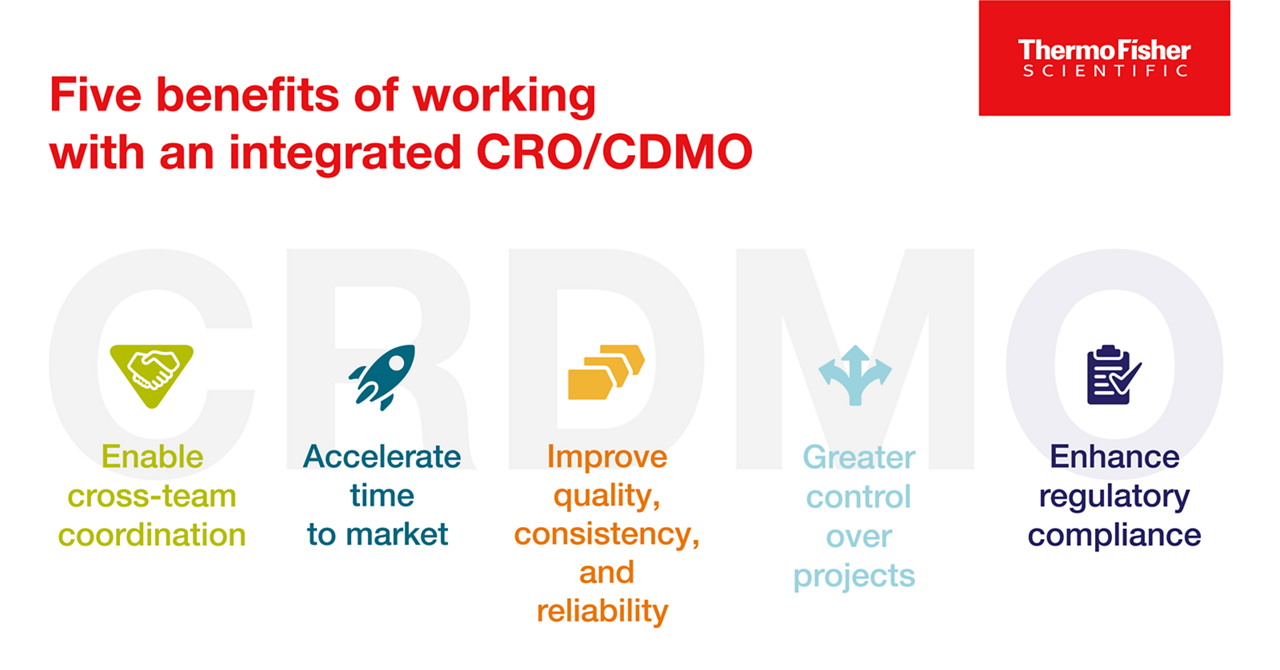Enter the CRDMO: Reshaping drug development through CRO/CDMO integration
Category | CDMO Services
As more small- and medium-sized biotechnology and pharmaceutical companies enter the market — and as R&D costs continue to skyrocket post-pandemic — outsourcing key aspects of research, development, and manufacturing to third-party vendors has become common practice. As a result, the global biotechnology and pharmaceutical services outsourcing market size was valued at $70.48 billion in 2022 and is expected to grow at a compound annual growth rate of 5.3% from 2023 to 2030.1
Typically, today’s drug developers collaborate with CROs, CMOs, and CDMOs to help meet their research, development, and manufacturing needs. However, many biotechnology and pharmaceutical companies would prefer a more streamlined approach to outsourcing these activities, rather than dividing them up between different third-party vendors.
To meet this demand, a new solution has emerged: integrated CROs and CDMOs, or CRDMOs, that provide end-to-end research, development, and manufacturing support. By working with a unified CRO/CDMO, drug developers can more confidently navigate the ins and outs of bringing new therapies to market, without the complexities of working with multiple outsourcing partners.
In this blog, we explore five benefits of working with an integrated CRO/CDMO, and the impact the newly formed entities have on the industry, including:
- Enable cross-team coordination
- Accelerate time to market
- Improve quality, consistency, and reliability
- Great control over projects
- Enhance regulatory compliance
Enable cross-team coordination
When working with different vendors for every stage of drug development, biotechnology and pharmaceutical companies must constantly transfer technology and disseminate knowledge between their teams. Otherwise, they run the risk of communication breakdowns and project delays. By enabling cross-team coordination between research, development, and manufacturing through integration, drug developers can improve and/or eliminate the need for external hand-offs, technology transfer, and knowledge dissemination altogether.
Accelerate time to market
By adopting a fully integrated approach to research, development, and manufacturing, drug developers can accelerate time to market by streamlining activities that a variety of fragmented vendors would otherwise handle. Additionally, integration allows them to leverage a connected network of internal experts to help eliminate downtime, optimize processes, and minimize errors. Having all relevant employees within one organization also facilities quicker decision-making to overcome challenges more efficiently.
Improve quality, consistency, and reliability
Through end-to-end integration, drug developers can ensure all products and processes are guided by the same high-quality standards throughout the research, development, and manufacturing journey — reducing the risk of errors and inconsistencies that could compromise the safety and efficacy of new drugs. Additionally, a single vendor can more easily control which employees have access to information, which can help enhance the security of intellectual property.
Greater control over projects
An integrated CRO/CDMO provides greater control over research, development, and manufacturing projects, providing a single line of sight into all activities. Having an integrated organization for research, development, and manufacturing also helps to streamline project management, ensuring projects stay on track, timelines are met, and potential challenges are promptly addressed. To that end, a single vendor’s ability to look ahead at project schedules enables them to anticipate and resolve disruptions before they occur.
Enhance regulatory compliance
The biotechnology and pharmaceutical industries must abide by strict regulatory guidelines set by entities like the FDA and EMA. The ability to exercise comprehensive supervision over all research, development, and manufacturing initiatives — and also tap into their partner’s history of experience with various regulatory agencies — helps drug developers ensure their processes and procedures meet the same stringent quality control standards, thus reducing the likelihood of compliance holdups.
Why partner with an integrated CRO/CDMO?
On average, it takes about 10 to 15 years for a drug to be designed, developed, and approved for use in patients.2 From early discovery to clinical trials, large-scale manufacturing, and post-marketing surveillance, there’s a seemingly endless to-do list that biotechnology and pharmaceutical companies must tackle to move their drugs through to commercialization.
Thankfully, they don’t have to do everything alone — or even with multiple, disjointed vendors. By partnering with an integrated CRO/CDMO, or CRDMO, capable of managing key research, development, and manufacturing tasks under one roof, the process becomes streamlined. Meanwhile, drug developers can focus their attention on other core tasks that help bring new medicines to market quickly and safely.
Discover how end-to-end, integrated CDMO and CRO services can help speed up your drug development journey.
View references



